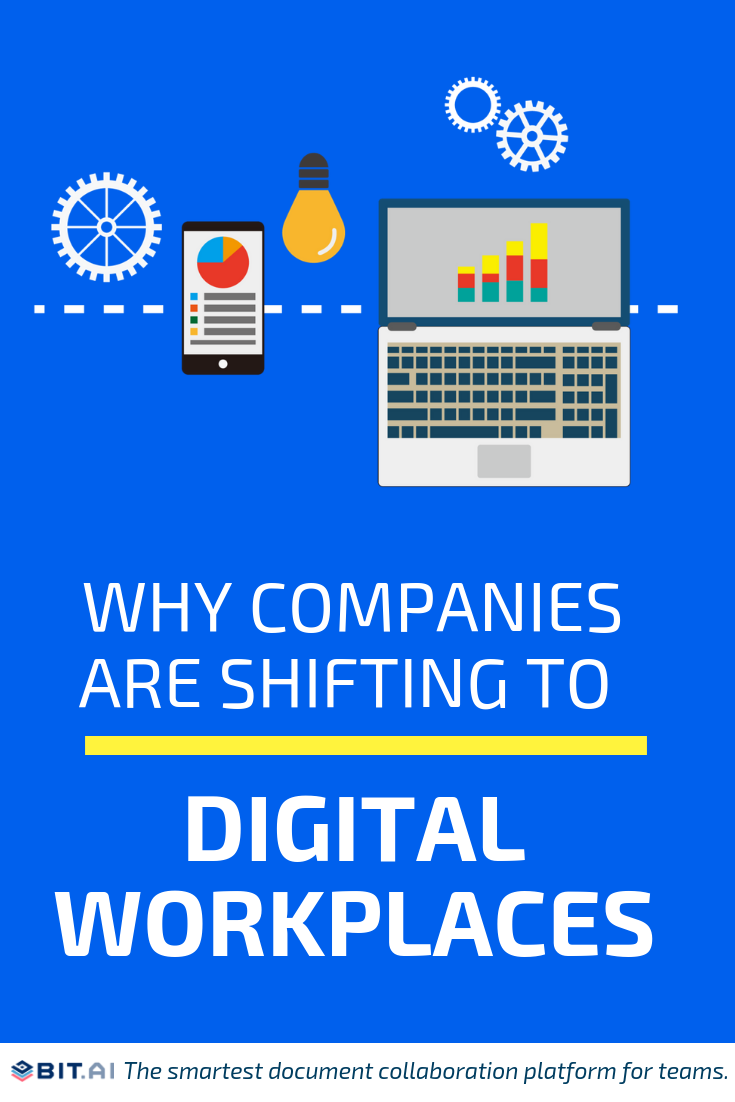Digital workplaces are changing the way we communicate, collaborate, and work in general. Find out why it’s necessary to keep up and make the switch!
Technology is everywhere- our phones, laptops, PCs, tablets, watches, speakers, fridges, and even our microwaves are getting smarter day by day! Yep, all of these electronics are making our lives easier and keeping us connected.
Our personal lives and our workplaces are infiltrated by these ‘smart devices’. Today’s instant access environment has significantly blurred the lines between the physical office and the place where work actually happens. The days of sitting in your office cubicle eight hours a day are slowly disappearing. So are the gaps between our personal and professional lives!
With technological innovations occurring at an exponential rate, companies are focusing on how to make this digital transformation as smooth and natural as possible.
Technology has not only allowed us to build apps and games but has drastically increased office efficiency and productivity. From brainstorming and product development to HR and customer service, technology has taken over every aspect of business operations.
This brings us to the topic of today’s discussion- why companies are shifting to digital workplaces. Our workplaces, aka ‘the places we do our work from’ are increasingly becoming digitized in every possible way.
It’s time to see why companies are actually shifting to these digital workplaces and how digitization actually leads to a better work environment and increased office efficiency!
Why Companies are Shifting to Digital Workplaces?
Organizations are slowly coming to terms with the fact that work is no longer a place we go to. In fact, it’s a virtual modern counterpart to the traditional office space where work comes to us, courtesy of technological advancements!
There are many reasons why a digital workplace is absolutely necessary to carry out business in today’s day and age. Some of these include:
1. Environment-friendly!
Did you know that companies with annual revenues between $500k and $1 million can save as much as $40k per year by switching to digital document management solutions? Laserfiche estimates a 20% time savings based on filing and retrieval efficiencies, eliminating misfiling and workflow efficiencies.
Increased efficiency, as well as greater staff productivity, can save up to 6,000 hours annually, or 2.4 full-time staff positions. Going paperless and shifting to a digital workplace is not only a conscious effort to save to the environment, but also make economic sense for businesses

If your company still uses paper documents, switching to a digital workplace can help reduce the reliance on paper and save additional costs for printing, storing, maintenance, filing, etc.
This not only helps you make sustainable and ethically correct choices, but also provides you with a social mission of which both clients, employees, governments, and your customers, want to be a part of.
2. Increased Efficiency
Running a business in 2018 is all about being efficient; doing more in less time. Technology has played a huge role in getting us up there with being 100% efficient and constantly strive for more.
Work overload decreases productivity by 68% in employees who feel they don’t have enough hours in the day to complete their tasks.
Digital workplaces can help increase productivity by getting rid of commute times, time spent searching for information, as well as time spent on other administrative tasks that technology can do quickly. Thus, digital workplaces help save you crucial time and resources, making you more efficient at work!
Read more: 10 Productivity Tools that will Help You Achieve More in Less Time
3. Improved Customer Service
As much as 75% of people say they spend more with a company that has a history of providing positive customer service. People want prompt and helpful customer service and they want it now!
Thanks to the digitization of the workplace, you can have all company information- troubleshooting guides, how-to manuals, FAQs, etc. all in one place. This allows service reps to provide a faster, better and more informed customer experience.

The vast amount of information present at customer’s fingertips has empowered them to make better-informed purchase decisions, thus changing the kind and quality of products and services they expect from the businesses they interact with.
Having digital workplaces allows businesses to keep up with customer expectations and succeed in the world we live in.
4. Improved Communication and Collaboration
A staggering 86% of employees and executives blame lack of collaboration or ineffective communication for workplace failures. Communication and collaboration play a huge role in getting messages across in an organization and get work done without hiccups or delays.
A digital workplace provides a virtual space for all of your teammates to know what’s going on in the company. It opens up an amazing number of opportunities to keep in touch with your peers at all times. In this fast-paced world, people can’t afford to wait for an email reply, or worse, let it get lost in your inbox wasteland.
People prefer newer, faster communication tools specifically instant messaging and real-time collaboration tools to get work done quickly. Over 49% of Millennials support social tools for workplace collaboration.
In fact, about 40% of Millennials would even pay out of pocket for social collaboration tools to improve productivity. That’s how much they believe in the ‘dream team’ of collaboration and technology.
Read more: What is Workplace Collaboration & How To Do It Right!
5. Information Access
Have you ever wondered where that PSD file is that your colleague emailed you last month? Or in which Dropbox folder you put your sales pitch in?
We bet you have no idea how much productive time your employees are leaving on the table just because they couldn’t find the desired information or content they were looking for.
Since all your important work documents are scattered over Google Drive, OneDrive, email attachments, PC folders, and USB sticks, it becomes an impossible search mission to quickly find that exact piece of information you need, at the time you need it!

According to a McKinsey report, employees spend 1.8 hours every day—9.3 hours per week, on average—searching and gathering information.
Almost 20 percent of the business time – the equivalent of one day per working week – is wasted by employees searching for information to do their job effectively.
Digital workplaces handsomely solve this problem by allowing teammates to have all of their content and information in one place.
Having a central location for all files, documents, weblinks, and other rich media makes it extremely easy for employees, irrespective of their location to access information from any device quickly.
6. Helps in Knowledge Management and Sharing
What happens if your operations director with years of experience decides to work somewhere else or retires? He/she takes the knowledge with them and it becomes an uphill battle.
This knowledge is extremely useful in teaching new hires about the ins and outs of your business and quickly lay the foundation of a much more efficient workforce.
According to data, Fortune 500 companies lose roughly $31.5 billion a year by failing to share knowledge. That’s a lot of dollars if you ask me!
Digital workplace tools like knowledge management systems allow organizations to preserve the know-how and experience of senior managers so that the knowledge of the organization does not leave when the employee leaves.
With a knowledge management system in place, your current or future employees can easily access this information and continue doing their work without any hiccups.
7. Provides a Competitive Advantage
After going through the above-mentioned points, we can safely say that companies who employ digital workplaces clearly possess a competitive edge on those who still follow traditional ways of doing work.
To sum it all up, a complete digital transformation of your business allows companies to:
- Save money and resources by switching from paper to digital documents.
- Get access to information quickly and easily, saving employees time and effort.
- Manage knowledge throughout the organization
- Employees can provide better service to customers and offer better turnaround times.
- Emerging technologies like artificial intelligence and machine learning provide organizations with insights to drive more accurate decisions around marketing, sales, and product development.
- Improved internal as well as external communication and collaboration.
- Facilitates remote working and much more!
Since digital workplaces help employees save a lot of time and money, they can focus on the things that really matter and contribute to the business’s success more effectively.
Conclusion
In a recent Gartner survey, “56 percent said that their digital improvements have already improved profits.” Digital workplaces not only help save companies a lot of operating costs and resources, but they help preserve the most important asset of them all- time.
When employees can search that file quickly, save time spent on commuting, provide solutions to customers quickly, and get the work done more efficiently, it leaves them with a sense of satisfaction like never before. It’s about time that your business moves to a digital workplace too or else you’ll get left behind!
Further reads:
- Combating Social Isolation in Remote Working
- Focus at Work with the Help of These 11 Effective Ways!
- Virtual Workspace: Definition, Importance, and Tools
- Ultimate Guide to Workplace Productivity
- The Definitive Guide To Effective Workplace Communication
- Why Workplace Collaboration is More Important Than Ever?
- How Bit.ai Can Improve Your Team Collaboration?
[/vc_column_text]



